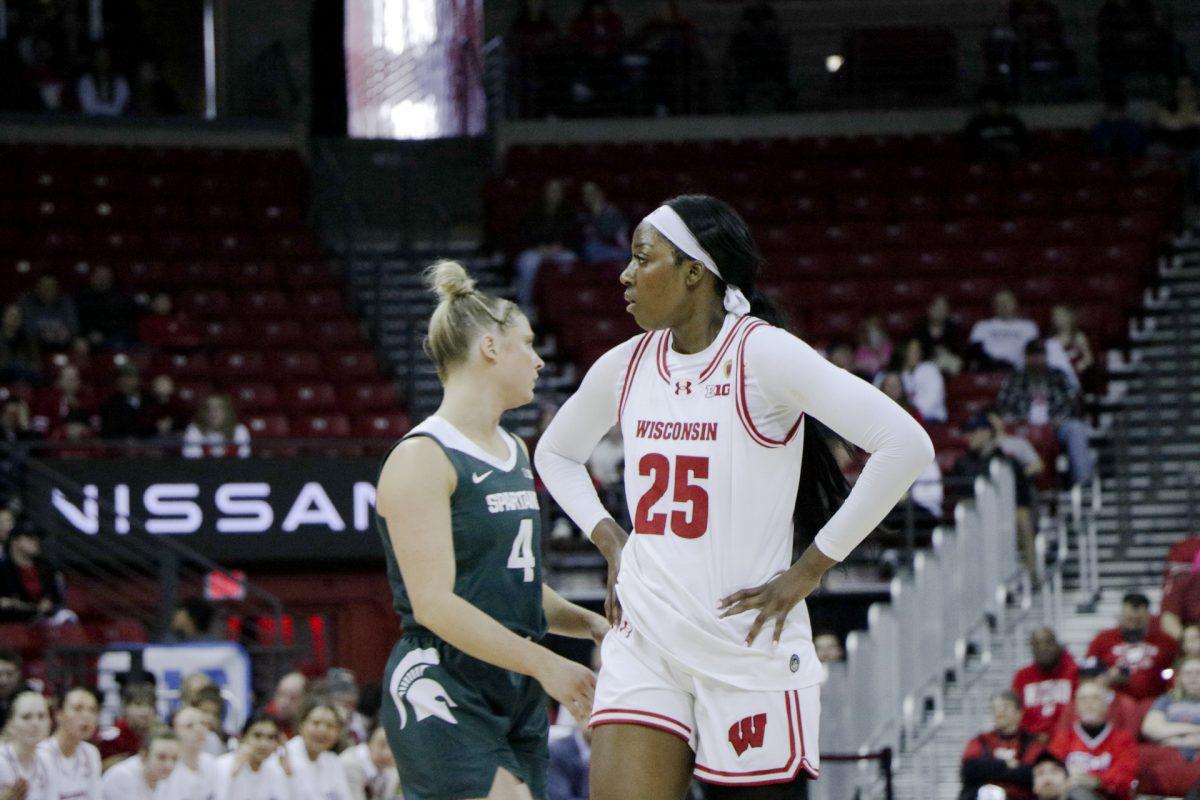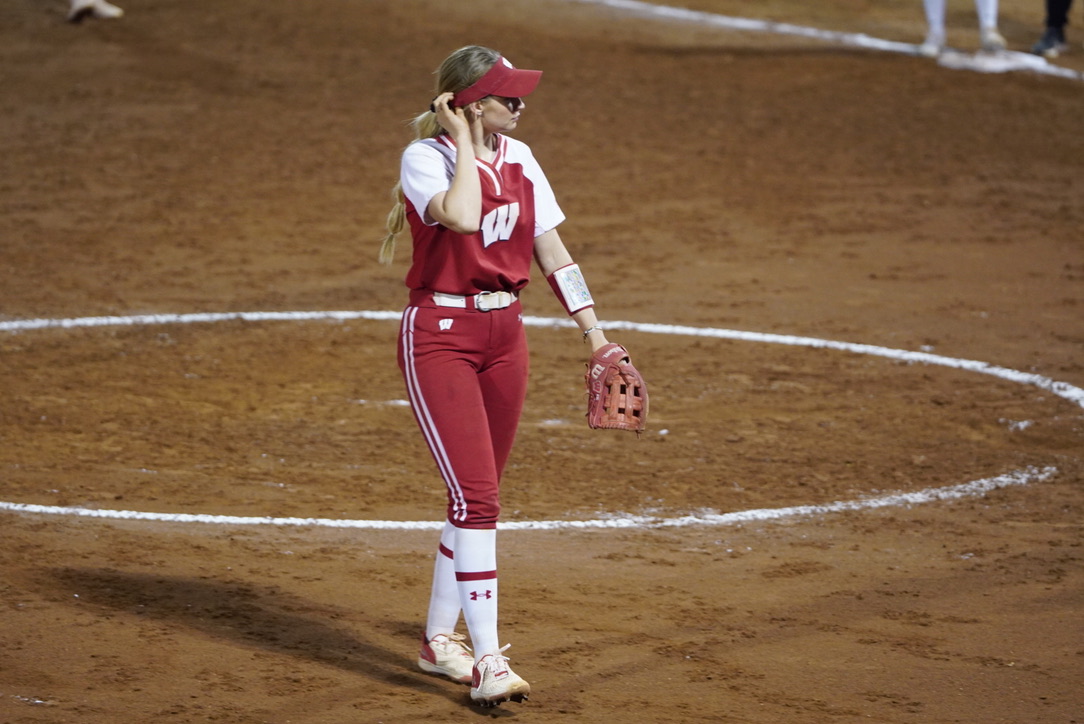Late in the first quarter of Wisconsin’s spring football game, star receiver Lee Evans went to make a catch over the middle.
He made the reception, just like he has so many times before.
Yet something was unique about the way this catch ended–Evans never got up off the field.
The flanker that turned down the NFL in order to return to his Badger team for his senior season lay on the artificial turf of Camp Randall in pain, clenching his knee.
The trainers ran to him, carried him off the field–he was unable to place any weight on his knee–and put him down safely on the UW bench.
There Evans sat, head hanging down, waiting for the cart to come carry him away. As he sat there, his teammates wandered over to offer words of encouragement to their teammate, as well as condolences.
After all, this required words of sympathy. Depending on the severity of the knee injury, their teammate might have ruined his career, a career that showed so much promise.
Evans was one of the top receivers in the country last season with 1,545 yards and 75 receptions. He was a Biletnikoff finalist and a top NFL prospect.
And on this very day that he hurt his knee, April 20, the NFL draft that he made himself ineligible for was taking place. While his colleagues were chosen by teams and given the opportunity to play at the next level, Evans was getting treatment done on his knee.
Two days later, Evans underwent an MRI that revealed the junior did in fact suffer ligament damage to his left knee–an injury that would require surgery. The Wisconsin State Journal reported that a source close to the team revealed the damaged ligaments were the anterior cruciate ligament and the medial collateral ligament. However, UW’s sports information office would not confirm the report.
The prognosis for Evans’ career is still undecided, with his playing status to be determined after surgery and the corresponding rehabilitation on the knee. If required, the junior will have the opportunity to request a medical redshirt for next season if he so chooses and save his last year of eligibility for the following season. Evans, who was thought to be amongst the top draft picks in 2003, would have another year to mend his injured knee in order to wow the professional scouts.
But if the unthinkable did happen, if this injury kept the junior out of the NFL, Evans has a small bit of piece of mind–an insurance policy.
****
A growing trend in elite athletes, Evans took out an insurance policy to cover him in case he was to suffer a career-ending injury. The policy is to guarantee the elite athletes money that they would lose by missing their chance to play at the professional level.
Among those who purchased policies during their collegiate careers were Indiana’s Antwaan Randle El, Tennessee’s John Henderson and Peyton Manning, Oklahoma’s Roy Williams, Colorado’s Donnie Boyce, Wisconsin’s Chris McIntosh, Wendell Bryant, Mike Echols, Ben Johnson, Al Johnson, and Evans.
In order to obtain an insurance policy the elite athletes must meet requirements set by the policy providers–either the NCAA or a private company. Within each program the requirements are slightly different, yet the basics are the same–you must pay a premium on your policy, and you can only collect the money if you suffer a career-ending injury.
In the NCAA’s policy, called the Exceptional Student-Athlete Disability Insurance, only athletes participating in football, men’s and women’s basketball, baseball and ice hockey are eligible. Within these sports the qualifications are more specific, needing to prove that you will in fact make it to the professional level in order to take out a policy.
For football and ice hockey, athletes must demonstrate they will be selected in the first three rounds of the upcoming NFL or NHL draft. In order to obtain a policy for basketball or baseball, athletes must be projected first round picks of the MLB, NBA or WNBA draft.
The reason for this is simple. According to a member of Wisconsin’s Assistant Athletic Director and head of the compliance staff, Tim Bald, the NCAA instates these guidelines in order to ensure that the athlete will have enough money to pay for the policy they are taking out.
The NCAA automatically makes student-athletes that qualified for the insurance policy eligible for a loan in order to pay the premiums of their policy.
According to the NCAA guidelines for the Exceptional Student-Athlete Disability Insurance, athletes must re-pay their loans in full when one of three instances occurs.
“When the student-athlete signs a professional contract; the disability benefits become available due to a covered injury or sickness; or the coverage is no longer in effect and the loan matures,” as stated in the NCAA guide.
The NCAA’s policy covers athletes for a maximum of 24 months, and it covers the athlete for all practices and games during this time period.
If an athlete should suffer a career-ending injury during this two-year span, the NCAA states that it will provide up to five installment payments with one issued every six months. Each payment is worth 20 percent of the total policy purchased.
In order to actually receive these payments, the NCAA states that, “To be eligible for benefits, it must be medically determined that the insured student-athlete will not be able to participate in his or her sporting activity, at the professional level, for at least three consecutive years from the date the total disability was determined.”
In other words, if an athlete is injured but is able to recover from his or her injury, they receive no benefits.
Three athletes that took the financial gamble on the NCAA insurance policy were Boyce, Henderson and Williams.
Boyce, in fact, fell victim to the insurance policy.
During the 1995 Big Eight basketball tournament, Colorado’s senior guard suffered a broken tibia and fibula when he was hit while trying to get a rebound. Boyce eventually mended his leg and was able to play basketball again, but his professional career was ruined. The Buffalo guard was able to play only 30 games for the Atlanta Hawks before his leg injury ended his NBA career.
According to Bald, the NCAA policy can be redeemed only if an athlete’s injury keeps them from reaching the professional level.
Because of this, Boyce would not be able to cash in his NCAA insurance policy.
****
While the NCAA’s Exceptional Student Athlete Disability Insurance staff says there are currently 70 athletes covered by their policy (a number that fluctuates with each sport’s corresponding draft), many elite athletes opt to gain a policy through a private insurance company.
The difference between the NCAA’s policy and private companies are less strict guidelines–you don’t necessarily have to be a top three or first round draft pick, and the policies are available for higher amounts.
When Michael Vick contemplated whether or not to return to Virginia Tech, the Washington Post reported that his coach offered to help him obtain a $10 million policy if he chose to play for him another year.
But not all policies are that extravagant. Each company has its own set of rules and methods to determine whether or not it will cover an athlete, and how big of a policy it will give him or her.
Evans said his policy through a private company is worth $2 million; a value he said was determined by his draft status.
“[The insurance company determined] it by projected draft status, where you are at,” said Evans. “They look at a lot of different things, some of the things that the media does, and they talked to a lot of NFL people, their draft board, things like that.”
Evans’ teammates, Al and Ben Johnson, also have insurance policies through private companies. Al Johnson was a projected third-round pick in this year’s NFL draft, had he opted to declare for it, and his cousin Ben was a projected fourth-round pick. Under the guidelines of the NCAA policy, Ben wouldn’t have qualified for the NCAA’s insurance.
Instead, Al and Ben’s offensive line coach, Jim Hueber, set up the policies for the two cousins through a private company.
“[Hueber] goes through, gets the quotes and how much you’ve got to pay,” Al Johnson said. “Because then if you don’t get hurt you’ve got to pay back a premium, that’s usually like one percent, or somewhere around that range. So for like a million dollars you pay back somewhere around 10-15 thousand.”
Because of this premium that must be repaid, not all athletes are guaranteed coverage through private companies.
According to Bald, private insurance companies will still more than likely only insure the top, elite athletes that they know are going to proceed to the next level in order to ensure getting paid for the policy.
Similar to the NCAA’s policy, private insurance companies will also only offer redemption of policies to those athletes that suffer career-ending injuries. This means there is no coverage against treatable injuries.
“The only way we get the money though is if our careers are done through a career-ending injury. So if you break your leg or something and you’re still able to come back, it doesn’t cover you,” UW’s tackle Ben Johnson said.
It is this very catch in the insurance policies that could end up keeping Evans from obtaining any money through his policy after his knee injury. Even before he suffered the torn ligaments in his left knee, the Badger flanker was well aware of what injuries were not covered in his policy.
“It’s a policy where you only get paid really if you have a career-ending injury. So you know, say you tear your ACL or something, you don’t get the money. It’s not a career-ending injury. Many people have come back from that,” Evans said April 12, prior to suffering his knee injury.
Yet, despite the rarity of athletes receiving money from their insurance policies, the elite athletes are still getting them.
According to Ben Johnson, the ability to obtain an insurance policy was something that made it more favorable for him to return to UW rather than head to the NFL.
“Why come back if there’s the possibility of getting hurt?” Ben Johnson questioned.
For the Badger tackle, his insurance policy also provides peace of mind.
“Pretty much all of the older guys, Casey Rabach, Billy Ferrario, Chris McIntosh, they all took [an insurance policy] out, and they were glad they took it out,” Ben Johnson said of his former UW teammates. “They could go out their senior year and play 100 percent and not worry about getting hurt.”
But for Evans, his feelings about his insurance policy are different. He said the option of getting an insurance policy had no effect on his decision to return to UW for his senior season. For him, the policy is more of a precautionary measure against the unthinkable and nothing that protects him from injury on the field.
“As long as you don’t go out [on the field] playing not to get hurt, you’ll be fine. As soon as you get that mindset that you’re going out there, playing not to get hurt, that’s when you get hurt. If you just go out there and play the game, things will take care of themselves,” Evans said prior to his injury.
Evans did go out to play the game of football Saturday, April 20. A true competitor, the junior’s teammates said following the game that Evans wanted to play in the spring scrimmage. The flanker played, and he made catches that made it clear what is so special about him, and then he left the game on a stretcher.
If the worst case scenario should occur after Evans’ surgery and he is unable to make it to the NFL level, he’ll be able to redeem his $2 million insurance policy. But like the junior said, many people have come back from ACL and other ligament injuries. If that’s the case, then his insurance policy will be exactly what the Badger flanker considers it to be–a precautionary measure.













